Feed aggregator
Monday Musings: My Big Brother
People often ask why Nancy and I moved to New York when we left the Appalachians. We could have settled pretty much anywhere, but we chose an area — the Hudson River Valley — that few think of as a retirement destination. The fact is, a main reason we came here was to be near my brother and sister-in-law, whom we adore.
 Jim and me, birding in Arizona.
Jim and me, birding in Arizona.
As it happens, this is my brother’s birthday week, and so I am afforded a wonderful opportunity to embarrass him.
James Coe — Jim to me; Jimmy when we were much younger — is just about my very favorite person in the world. He is older than I am. I won’t say by how much, but trust me, it’s A LOT!! When we were kids, I wanted to do everything he did, often to his dismay. He was my babysitter, my early-life mentor, occasionally my tormentor, but throughout all my years my best friend. He was the one who interested me (and our oldest brother, Bill) in birdwatching. He shaped my early musical tastes, introducing me to James Taylor, Joni Mitchell, the Beatles, Crosby Stills and Nash, Carole King, Simon and Garfunkel, not to mention the Monkees and Young Rascals. Later, as I got older, he was my guide to jazz. He saw to it that I discovered pizza. He risked parental sanction by lighting off firecrackers for my entertainment (and the satisfaction of his own pronounced pyromaniacal tendencies).
Jim is a remarkably talented artist — you can find samples of his work, as well as his very impressive biography, here — and all kidding aside, his courage in pursuing his own unconventional artistic career emboldened me to do something similar in pursuit of my passion for writing fantasy. In a sense, I owe my career to his example. His art is all over our walls, and for all of my adult life, the best gift I could receive for any birthday has been an original James Coe painting. Over the years, he has been incredibly generous in that regard.
He is a bold and creative chef, an accomplished baker whose from-scratch bread rivals Nancy’s (and that, my friends, is saying something). He is wise and caring, a wonderful Dad to his talented, beautiful children, Jonah and Rachel, a loving spouse to his spectacularly brilliant wife, Karen, and a marvelous uncle to our girls. He is, to this day, my favorite birding companion, my constant partner in silliness, my beloved big brother.
So, please wish Jim a happy birthday, and really do check out his website. He is annoyingly talented.
Love you, Coe.
Spotlight on “Gifted and Talented” by Olivie Blake
In Gifted and Talented, three siblings are forced to reckon with their long-festering rivalries, dangerous…
The post Spotlight on “Gifted and Talented” by Olivie Blake appeared first on LitStack.
Monday Meows
Confession time, guys. I think I might have a drinking problem.
Really? No one could have guessed that. I’m surrounded by idiots.
There’s one above you.
And one below you.
We are legion. Also, why are you all upside down?
Was Don Newcombe a Hall of Famer? – Spring means Baseball
 I have occasionally strayed off topic here at Black Gate, KISS, the Beach Boys, Humphrey Bogart…stuff like that. I played tee-ball as a tyke and have loved baseball my whole life. With a new season dawning (one in which my beloved Dodgers are the reigning World Series champs for the fourth time since I was born), I wanted to talk baseball. And I think that sharing about Don Newcombe is the way to do it.
I have occasionally strayed off topic here at Black Gate, KISS, the Beach Boys, Humphrey Bogart…stuff like that. I played tee-ball as a tyke and have loved baseball my whole life. With a new season dawning (one in which my beloved Dodgers are the reigning World Series champs for the fourth time since I was born), I wanted to talk baseball. And I think that sharing about Don Newcombe is the way to do it.
In 1949’s (sappy) It Happens Every Spring, Ray Milland’s chemistry professor suffers through his life half of the year, to get to baseball season.
Lord Tenneyson said ‘In the Spring a young man’s fancy lightly turns to thoughts of love.’ For a long time, it was baseball, not love, that young men thought of in American Spring.
When Spring Training would roll around in Florida (and then later, also in Arizona), I used to say “If they’re playing baseball somewhere, there’s till some hope for the world.” I’m not sure I believe that in these messed-up days. But the Dodgers (the epitome of a small-market, hard-working franchise, competing against big city, big money teams – HA HA HA) are working out and playing games in Arizona. It’s baseball season, which helps me ignore that my Ohio wind chill is 15 degrees right now.
The Dodgers and Yankees met in the World Series in 1947, 1949, 1952, 1953, 1955 and 1956. It was a glorious era for NYC baseball (and the Giants were a powerhouse as well), though Brooklyn managed to win only the 1955 matchup.
The greatest advantage that the Yankees had was their starting pitching. Whether it was Eddie Lopat, Allie Reynolds, Whitey Ford, Bob Kuzava or Don Larsen, the Bronx Bombers always seemed to come up with somebody in big moments (if not for Cookie Lavagetto, Bill Bevens would be included on that list).
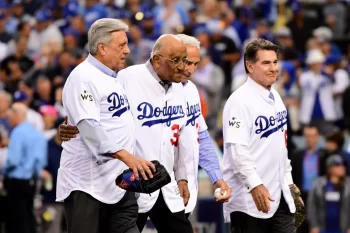 Rick Monday, Newcombe, Sandy Koufax, and Steve Garvey
Rick Monday, Newcombe, Sandy Koufax, and Steve Garvey
During this era, Don Newcombe rose above other Dodger would-be aces such as Carl Erskine, Ralph Branca and Johnny Podres (though the latter certainly carried the flag in the 1955 Series). Big Newk missed the 1952 and 1953 seasons, as he was serving his country, fighting in Korea. And his 1954 season was a poor one: it took him a year to get back to form after being released from service.
But from 1949-1951 and 1955-1956, Newcombe went a combined 103-40, with 92 complete games. Those are some impressive numbers for the 1949 Rookie of the Year.
However, he got a reputation as a choker in big games. He went all ten innings against the Phillies on the final day of the 1950 season, with the Dodgers needing a win to force a playoff. But he gave up a three run homer to Dick Sisler in the top of the tenth in the season-ending 4-1 loss (which would have been a win if third base coach Milt Stock had simply held Cal Abrams at third in the bottom of the ninth).
He carried a 4-1 lead into the ninth inning of that famous game three playoff against the Giants in 1951. But he couldn’t hold on and he had been relieved by Ralph Branca when Bobby Thomson hit the home run heard round the world.
And in three World Series’, he just couldn’t get the job done for the Dodgers. He started 5 games, going 0-4 with an ERA of 8.59 and lasting about 4 innings a start. Dominating regular season, poor post-season: Shades of a great lefty named Clayton Kershaw, several decades and thousands of miles West, later (Kershaw is my second-favorite Dodger, after Jackie Robinson).
In 1956, he won the (very first) Cy Young Award and the NL MVP, going 27-7. But in the World Series he couldn’t make it out of the second inning of game two or the fourth in game seven. His drinking more directly impacting his performance, as well as his shoulder wearing out from the overuse, his career was effectively done, and he went a combined 37-42 in the four years after that Cy Young season.
He spent 1961 in the minors and he finished in Japan in 1962, as a first baseman. Newcombe was a career.268 batter, with 7 homers in 1955. He could have been a major league hitter.
A Trailblazer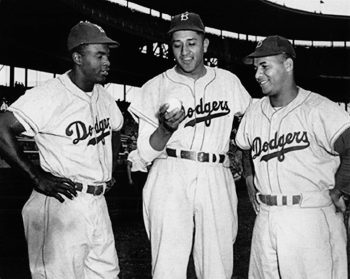 Newcombe was one of the first black players signed by the Dodgers. He and Roy Campanella played with Nashua of the New England League (B) in 1946. Newcombe returned there in 1947 (striking out 186), while Campanella played at AAA Montreal, and Jackie Robinson changed the world in Brooklyn.
Newcombe was one of the first black players signed by the Dodgers. He and Roy Campanella played with Nashua of the New England League (B) in 1946. Newcombe returned there in 1947 (striking out 186), while Campanella played at AAA Montreal, and Jackie Robinson changed the world in Brooklyn.
Newcombe was dominant in his two years at Nashua, going 33-10 with an ERA well under 3. He probably would have played in AA ball in 1947 but the Dodgers’ two AA teams were in the South and not yet ready to be integrated. Apparently AAA wasn’t the best option, as it had been for Robinson and Campanella.
In 1948 he went 17-6 at AAA Montreal (while Campy began his Hall of Fame career in Brooklyn). He threw his only no hitter, won three games in the first round of the International League Playoffs (losing another game 0-1), and then won a game in the Governor’s Cup series. He then went 1-1 as the Royals defeated the Dodgers’ other AAA team (St. Paul) for the Junior World Series. Newcombe dominated AAA.
He got called up to the Dodgers early in 1949. He was only the second black pitcher in the major leagues and the first good one (Dan Bankhead pitched in four games for the Dodgers in 1947).
Jackie Robinson deserves every praise and accolade. But Don Newcombe was the first man to prove an African-American could pitch in the major leagues. He hit 3 batters as a rookie, and 6 his third year. But there were no racial issues about a black pitcher hitting a white batter. It didn’t hurt that he was 6’-4”, 220. But his success, and his acceptance on the field, made him a pioneer, though he never received the credit he deserved for that.
Close to Cooperstown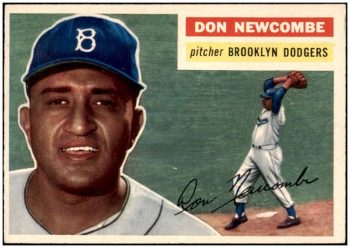 His raw numbers are lacking in HoF dazzle: 153-96, with a 3.57 ERA.
His raw numbers are lacking in HoF dazzle: 153-96, with a 3.57 ERA.
He does have one Rookie of the Year, one MVP, and one Cy Young award, along with one World Series ring, and he was a four-time All Star. That’s what is. But we can also look at a few ‘What ifs.’
There are four distinct elements of his career that might have changed his possible Hall of Fame path:
1) Newcombe’s first two seasons were spent with the Newark Eagles in the Negro Leagues. It’s fair to say that he might have developed more quickly with two years in the Dodgers’ system. But he was only 18 that first year. Maybe the hard experience of playing in the Negro Leagues had some benefits for him.
2) He lost a season, maybe two, to baseball’s color barrier. It’s a foregone conclusion that he would have done better than Dan Bankhead did. He was 17-8 with 19 complete games and a league-leading 5 shutouts as a 23 year-old rookie. That’s a pretty good start.
3) And he lost nearly two peak seasons to the Korean War. Plus his first year back was basically a lost one as well. He easily could have had three more 20 win/single-digit loss seasons.
Give him 60 more wins for the Korean War years, and there would be a dozen pitchers with fewer wins who are in the Hall of Fame, including two Dodgers (Don Drysdale, Dazzy Vance).
4) Finally, had Newcombe pitched better in the World Series (especially in 1956), he might well have continued on as one of the NL’s top pitchers, instead of spiraling deep into alcoholism.
With two more outs, it’s Newcombe, not Bobby Thomson, who is the hero of the 1951 NL playoff series (playoffs only occurred if two teams were tied at the end of the season. MLB did not adopt divisions and regular playoffs until 1969).
And with post-season success, the media might have lightened up (racism was certainly involved, but everyone loves a winner – somewhat). And he might have been more at ease if he wasn’t so clenched up inside from the criticism (Conversely, Newcombe was not appropriately praised for when he excelled, which he often did.).
That fourth factor (the postseason) was certainly within his control. But if the first three things had gone a bit differently, Don Newcombe might well be in the Hall of Fame today.
He and Justin Verlander are the only players to win the Rookie of the Year, Cy Young and MVP awards. That speaks volumes.
He Was Criticized Unjustly in the Press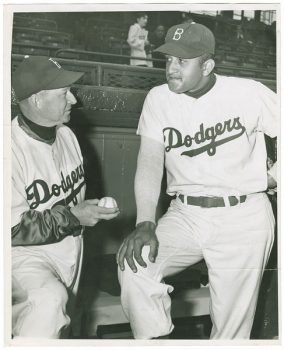 If you’ve read books about Jackie Robinson, you know the abuse that racist sportswriters (and fans, and players, and…) heaped upon him. Other early trailblazers like Newcombe were also the subject of vitriol. On September 14, 1951, Tommy Holmes of the Brooklyn Eagle – under the headline Is Newcombe Ailment a Case of Imaginatis? – wrote a scathing, rumor and innuendo-filled attack on Newcombe, which never would have been written about a white pitcher. Excerpts can be found in Jon Weisman’s book on Dodgers pitching, Brother in Arms. It’s a pathetic piece of non-objective ‘journalism’.
If you’ve read books about Jackie Robinson, you know the abuse that racist sportswriters (and fans, and players, and…) heaped upon him. Other early trailblazers like Newcombe were also the subject of vitriol. On September 14, 1951, Tommy Holmes of the Brooklyn Eagle – under the headline Is Newcombe Ailment a Case of Imaginatis? – wrote a scathing, rumor and innuendo-filled attack on Newcombe, which never would have been written about a white pitcher. Excerpts can be found in Jon Weisman’s book on Dodgers pitching, Brother in Arms. It’s a pathetic piece of non-objective ‘journalism’.
For example, Holmes asserts that ‘experts’ expected Newcombe to win 30 games that season, and instead of doing so, he was complaining about a sore arm. Dizzy Dean won 30 games in 1934. Exactly one pitcher has done so (that’s a good trivia question – go look it up) in the 90 seasons since. Holmes wrote an ‘uppity negro’ piece on Newcombe, and it was wrong in EVERY way.
As Chuck Dressen desperately tried to stop the Dodgers’ epic collapse (they led by 13 games in August), he kept throwing a tired (Newk led the team in innings pitched and had 18 complete games) and sore-armed Newcombe out there.
Newcombe started on September 17th, lasting only 6 and two-thirds. On the 22nd, he only made it 5 innings. On the 26h, he threw a complete game in a 15-5 win (you think Dressen couldn’t have given him a few innings off in a ten run win?). Only three days later on the 29th, it was a complete game shutout. And the very next day in the must-win season-finale, Dressen had him pitch 5 and two-thirds innings of relief. Big Newk gave up one hit and no runs as the Dodgers won 9-8, forcing the three-game playoff that made Bobby Thomson a baseball legend.
On only two days rest, after that heavy workload, Newcombe pitched 8 and one-third innings in that third-game loss. He had performed an even more impressive feat of carrying the team to the final day of the season the year before.
Holmes and other writers (and NYC baseball writers were celebrities in their day) wrote about Newcombe from their racist beliefs, not as objective observers. He was a workhorse who carried Dodgers teams to the brink of championships.
Alcoholism and RebirthNewcombe succumbed to life-long alcoholism. While he made the choice to drink, the unrelenting (and unreasonable) pressure he was subjected to, along with racist abuse, surely contributed to its severity. He declared bankruptcy in 1965 (he sold his World Series ring, which future Dodgers owner Peter O’Malley later bought and returned to him), and later divorced.
But he stopped drinking, straightened out his life, and was the Dodgers’ Director of Community Relations for over forty-five years, passing away in 2019. He became a leader in several organizations inside and outside of baseball, related to beating alcoholism.
Newcombe reflected on his career being cut short:
“I was only 34, but the alcohol had taken its toll. I think it shortened my major-league career by about six or seven years. I regret that I didn’t take better care of myself in the latter part of my career because I would like to have made the Hall of Fame, where I think I belong.”
Don Newcombe was haunted by his own demons, but found his own personal redemption. And with better handling on the Dodgers’ part; a few more seasons in the majors; and some more self-control, he could well be in Cooperstown today.
Newcombe recounted a conversation he had with Martin Luther King Jr.:
“Do you want to know what Jackie’s impact was? Well, let Martin Luther King tell you. In 1968, Martin had dinner in my house with my family. This was 28 days before he was assassinated. He said to me, ‘Don, I don’t know what I would have done without you guys setting up the minds for people for change. You, Jackie (Robinson) and Roy (Campanella) will never know how easy you made it for me to do my job.’ Can you imagine that? How easy we made it for Martin Luther King?”
He was an under-appreciated trailblazer, who rewrote his own personal story and played a major part in Dodgers’ history, on and off the field. And he wasn’t as far from a Hall of Fame career as one might think. It’s a shame no one worked with him to write a biography. It would have been a terrific book. He passed in 2019.

Bob Byrne’s ‘A (Black) Gat in the Hand’ made its Black Gate debut in 2018 and has returned every summer since.
His ‘The Public Life of Sherlock Holmes’ column ran every Monday morning at Black Gate from March, 2014 through March, 2017. And he irregularly posts on Rex Stout’s gargantuan detective in ‘Nero Wolfe’s Brownstone.’ He is a member of the Praed Street Irregulars, founded www.SolarPons.com (the only website dedicated to the ‘Sherlock Holmes of Praed Street’).
He organized Black Gate’s award-nominated ‘Discovering Robert E. Howard’ series, as well as the award-winning ‘Hither Came Conan’ series. Which is now part of THE Definitive guide to Conan. He also organized 2023’s ‘Talking Tolkien.’
He has contributed stories to The MX Book of New Sherlock Holmes Stories — Parts III, IV, V, VI, XXI, and XXXIII.
He has written introductions for Steeger Books, and appeared in several magazines, including Black Mask, Sherlock Holmes Mystery Magazine, The Strand Magazine, and Sherlock Magazine.
Review: The Raven Scholar by Antonia Hodgson

FORMAT/INFO: The Raven Scholar will be published on April 15th, 2025 by Orbit Books. It will be available in paperback, ebook, and audiobook formats.
OVERVIEW/ANALYSIS: Every 24 years, seven contenders from seven warrior temples match wits and blades in a series of trials designed to pick the next emperor of Orrun. It's a tradition that has largely ensured a peaceful transition of power for over 1500 years. But this year, one of the contestants is murdered on the eve of the competition. High Scholar Neema Kraa is charged with solving the murder, plunging her into a web of palace secrets. It isn't long before Neema realizes that people will kill to keep their secrets - and the only path to survival might be becoming emperor herself.
The Raven Scholar is an intricate, mesmerizing tangle of palace intrigue. This is a story with secrets upon secrets upon SECRETS. It's almost too many secrets, except that they are so carefully woven together, it makes the plot a delight to unwrap. Each revelation casts new light on past actions and motivations, while still keeping you guessing as to who the actual murderer is. If you're just here for the murder mystery alone, you'll have plenty to keep you entertained.
All of this is supported by the very deliberate pacing of the book. The Raven Scholar takes its time setting up the story. Lead character Neema Kraa doesn't arrive on the scene for multiple chapters, and the murder itself doesn't take place for well over 100 pages. But every chapter leading up to the murder is all in service of setting up the cast of characters, their relationships, and some very important recent historical events that personally affected everyone.
Most importantly, the story itself never drags, constantly making me want to read more. There are some doozy revelations that left me wide-eyed as I encountered the dark secrets in a character's past or realized the implication of new information. Again, it borders on too many things, but it's all so deftly woven together, it stopped short of feeling overstuffed.
I also applaud The Raven Scholar for being a story that is brutal and bloody without being gory and grim. Make no mistake, people will die and some very bad things will happen, but the author cuts away before it becomes too much. She also balances it out with a thread of humor strung throughout. Characters like the mischievous Fox warrior Cain or the ever dramatic Sol help break up the doom and gloom with some much needed levity.
I also have to shout out the magnificent use of the narrator in the story. While Neema is the lead character and the story is told in third person, this is being recounted to us by another. I won't spoil the surprise of who, but suffice to say it is deployed wonderfully. The bulk of the story follows Neema, but every now and then it swings away to follow other characters for a little bit, in a manner fully justified by the choice of narrator.
Neema herself is a scrappy, if brusque, lead. But most importantly, Neema is smart and she is competent, two of my favorite things in a protagonist. Her intellect and drive have made her one of the foremost scholars of her day. Unfortunately, her background of hailing from a backwater town prevents her from being able to easily navigate the political waters of the court. It's not that she doesn't understand the game, it's that the elite courtiers would rather shut her down than play the game with her at all, no matter how high she rises.
CONCLUSION: The Raven Scholar checks every box of things I love in a book. It has a compelling lead, a mystery that truly keeps you guessing, and a brutal competition for the throne. This is the kind of book that when I wasn't reading it, I was thinking about wanting to read it. I powered through the final 200 pages in one sitting because I simply couldn't stand dragging it out any longer. I had to inject this book into my veins as soon as possible, and now I'm staring at that most dreadful fate: waiting for the next book. But given how amazingly well done this first book was, I have every confidence that I will devour the sequel with equal speed.
Comment on End of Winter Update by DuffenBlaster
>the provisional release date is 4th November, 2025.
Let’s go!!!
The Leaning Pile of Books
The Leaning Pile of Books is a feature in which I highlight books I got over the last week that sound interesting—old or new, bought or received in the mail for review consideration. Since I hope you will find new books you’re interested in reading in these posts, I try to be as informative as possible. If I can find them, links to excerpts, author’s websites, and places where you can find more information on the book are included, along […]
The post The Leaning Pile of Books first appeared on Fantasy Cafe.Half a Century of Reading Tolkien: Part Three – The Two Towers by JRR Tolkien
 Gollum sat up again and looked at him under his eyelids. ‘He’s over there,’ he cackled. ‘Always there. Orcs will take you all the way. Easy to find Orcs east of the River. Don’t ask Sméagol. Poor, poor Sméagol, he went away long ago. They took his Precious, and he’s lost now.’
Gollum sat up again and looked at him under his eyelids. ‘He’s over there,’ he cackled. ‘Always there. Orcs will take you all the way. Easy to find Orcs east of the River. Don’t ask Sméagol. Poor, poor Sméagol, he went away long ago. They took his Precious, and he’s lost now.’
‘Perhaps we’ll find him again, if you come with us,’ said Frodo.
‘No, no, never! He’s lost his Precious,’ said Gollum.
Sméagol from The Taming of Sméagol of The Two Towers
When I was younger, The Two Towers (1954) seemed to suffer from middle-book syndrome: the bits after the start of series that had to be trudged through in order to reach the exciting end. Not all of it — it does feature a big battle complete with magic and explosives — but Frodo, Sam, and Smeagol’s trek to Mordor sometimes felt as arduous for me to read as it was for them to cross the swamp and slag heaps. Now, I believe The Two Towers, and the second half, The Ring Goes East, is the heart of the whole series. Nowhere does Prof. Tolkien speak more clearly on the weight of war, the burden and necessity of standing against evil, and the eroding effects of that duty.
The Two Towers has some of the most powerful writing in all the trilogy. There are several passages that have never failed to move me. That one of the most powerful of these lines was taken away from Sam carelessly given to Bad Faramir (more on that atrocity later), is one of the greatest crimes among the many I hold against Peter Jackson.
It’s the book of the trilogy that contains the most obvious references to Tolkien’s own service at the Somme in 1916. In the comments on my first article in this series, Half a Century of Reading Tolkien: Part One, K. Jespersen wrote that the books tasted of ashes, a flavor he linked directly to the First World War. I don’t tastes ashes in the books myself, but there are chapters redolent of them.
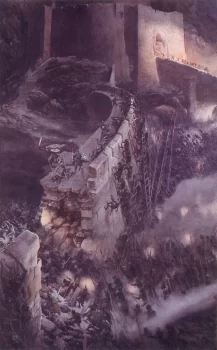 Battle of the Hornburg by Alan Lee
Battle of the Hornburg by Alan Lee
Again, for the uninitiated, a brief summary is in order. Following the disastrous events at the end of The Fellowship of the Ring, the Nine Walkers are split into three groups. Merry and Pippin, captured by a band of orcs, are dragged westward toward Isengard and Saruman. Frodo, with Sam insisting on accompanying, after Boromir’s attempt to seize the Ring, heads eastward toward Mordor and Mount Doom. Aragorn decides that Frodo and Sam might succeed on their own, but unless he, Legolas, and Gimli follow the other two hobbits, they will suffer torment and death.
The book’s first half, The Treason of Isengard, switches back and forth between Merry and Pippin’s travails, and Aragorn and his companions’ assorted adventures across Rohan. The two parties are reunited a week later after the return of Gandalf, the introduction of the Ents, great tree-like beings, and the Battle of the Hornburg (aka, the Battle of Helm’s Deep). The last is huge and murky in Peter Jackson’s film version, but on the page is tighter and far more tactically coherent.
The Ring Goes East, as I said, is the real heart of the trilogy. Frodo takes leave of his companions because he knows he must take the Ring to Mount Doom and that no one else can resist its malignant gravity. It also introduces Gollum/Sméagol. Gollum had been tracking the Nine Walkers from at least Moria, but he remained off stage. Now, he is captured and bound to Frodo after being made to swear on the Ring. Gollum, who calls the Ring his Precious, bore it for centuries. It twisted and hollowed him out, eating away at his mind and his soul. Now, he would do anything for its owner and, simultaneously, anything to repossess it.
Together, the trio cross the Dead Marshes, site of a great battle. Fought thousands of years before, images of the fallen, man, elf, and orc alike, linger on just below the surface of the marsh’s waters. Ghost lights flit over them, luring the unwary to their doom. Tolkien supposed that the battlefields of the Somme lived on in the Dead Marshes. He described how shell holes would be filled with water and the dead of both sides floated in them.
Clearing the swamps and finding Mordor’s main gate too formidable an obstacle, they head south to a secret way through the mountains Gollum claims can take them safely into Mordor. They meet their first men of Gondor, see an oliphaunt, witness the sallying forth of one of Sauron’s armies out of citadel so evil the ground around it is cursed, before starting on Gollum’s secret way. Things do not go well for any of them from there.
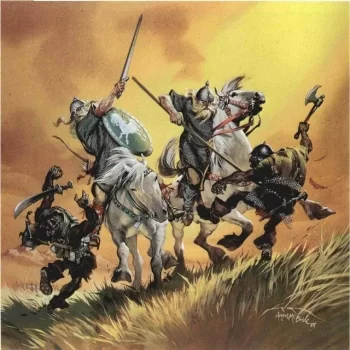 Riders of Rohan by Angus McBride
Riders of Rohan by Angus McBride
The Two Towers expands the reader’s vision of Middle-earth way beyond anything Tolkien displayed previously. The only human civilizations shown were the towns of Bree and Esgaroth. Now, we get to cross the expanse of the land of Rohan and meet its people, the Rohirrim. They been described as “Anglo-Saxon’s on horses,” which is reinforced with their Saxon-derived names such as Théoden, Éomer, and Éowyn.
Their horses were of great stature, strong and clean-limbed; their grey coats glistened, their long tails flowed in the wind, their manes were braided on their proud necks. The Men that rode them matched them well: tall and long-limbed; their hair, flaxen-pale, flowed under their light helms, and streamed in long braids behind them; their faces were stern and keen. In their hands were tall spears of ash, painted shields were slung at their backs, long swords were at their belts, their burnished shirts of mail hung down upon their knees.
It falls to the resurrected Gandalf to restore the king’s spirit so he can rouse his people and his forces against those of Saruman. Saruman once led the White Council against the resurgence of Sauron, but he came to betray them. Now he plans to conquer Rohan, Gondor’s only ally, and seize the Ring for himself.
And rouse the king, Gandalf does, which means we get one of Tolkien’s great epic moments. He doesn’t always show you the action in the books. We get the death of Boromir, Gandalf’s battle against the balrog, and the destruction of Isengard all second hand. Not this time. Instead, we get s brutal night battle against terrible odds and in harrowing detail, alleviated only a little by Gimli and Legolas’s banter over who’s killed more enemies.
It was now past midnight. The sky was utterly dark, and the stillness of the heavy air foreboded storm. Suddenly the clouds were seared by a blinding flash. Branched lightning smote down upon the eastward hills. For a staring moment the watchers on the walls saw all the space between them and the Dike lit with white light: it was boiling and crawling with black shapes, some squat and broad, some tall and grim, with high helms and sable shields. Hundreds and hundreds more were pouring over the Dike and through the breach. The dark tide flowed up to the walls from cliff to cliff. Thunder rolled in the valley. Rain came lashing down.
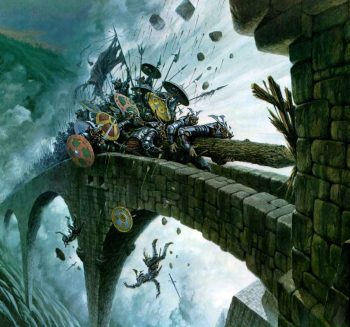 The Battle of Helm’s Deep by Darrell K Sweet
The Battle of Helm’s Deep by Darrell K Sweet
Arrows thick as the rain came whistling over the battlements, and fell clinking and glancing on the stones. Some found a mark. The assault on Helm’s Deep had begun, but no sound or challenge was heard within; no answering arrows came.
The assailing hosts halted, foiled by the silent menace of rock and wall. Ever and again the lightning tore aside the darkness. Then the Orcs screamed, waving spear and sword, and shooting a cloud of arrows at any that stood revealed upon the battlements; and the men of the Mark amazed looked out, as it seemed to them, upon a great field of dark corn, tossed by a tempest of war, and every ear glinted with barbed light.
Brazen trumpets sounded. The enemy surged forward, some against the Deeping Wall, others towards the causeway and the ramp that led up to the Hornburg-gates. There the hugest Orcs were mustered, and the wild men of the Dunland fells. A moment they hesitated and then on they came. The lightning flashed, and blazoned upon every helm and shield the ghastly hand of Isengard was seen. They reached the summit of the rock; they drove towards the gates.
Then at last an answer came: a storm of arrows met them, and a hail of stones. They wavered, broke, and fled back; and then charged again, broke and charged again; and each time, like the incoming sea, they halted at a higher point. Again trumpets rang, and a press of roaring men leaped forth. They held their great shields above them like a roof, while in their midst they bore two trunks of mighty trees. Behind them orc-archers crowded, sending a hail of darts against the bowmen on the walls. They gained the gates. The trees, swung by strong arms, smote the timbers with a rending boom. If any man fell, crushed by a stone hurtling from above, two others sprang to take his place. Again and again the great rams swung and crashed.
The Treason of Isengard was probably my favorite part of The Lord of the Rings when I was young. It’s got action and adventure and lots and lots of cool things. I remember me and my dad debating exactly what Orthanc and Meduseld looked like. Gandalf reappears and we learn about the palantír. The reunion of Merry and Pippin with Gandalf and company in Isengard is one of the funniest moments in the books. It all terrific, but it’s in The Ring Goes East, though, where the deepest themes of The Lord of Rings are developed.
Frodo and Sam march off toward Mordor knowing they probably won’t return, but they know it must be done. Defending what is right comes with a cost that leaves no one unchanged. It is too easy to fall in love with bloody deeds for themselves and forsake the things that might be lost.
In the middle of an attack by a band of Gondorian rangers on a force of enemy soldier, Sam meets the enemy up close for the first time.
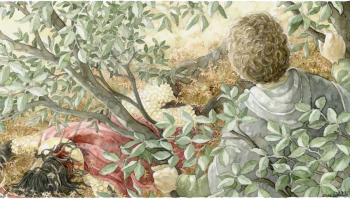 The Fallen Southron by Anke Eißmann
The Fallen Southron by Anke Eißmann
Sam, eager to see more, went now and joined the guards. He scrambled a little way up into one of the larger of the bay-trees. For a moment he caught a glimpse of swarthy men in red running down the slope some way off with green-clad warriors leaping after them, hewing them down as they fled. Arrows were thick in the air. Then suddenly straight over the rim of their sheltering bank, a man fell, crashing through the slender trees, nearly on top of them. He came to rest in the fern a few feet away, face downward, green arrow-feathers sticking from his neck below a golden collar. His scarlet robes were tattered, his corslet of overlapping brazen plates was rent and hewn, his black plaits of hair braided with gold were drenched with blood. His brown hand still clutched the hilt of a broken sword.
It was Sam’s first view of a battle of Men against Men, and he did not like it much. He was glad that he could not see the dead face. He wondered what the man’s name was and where he came from; and if he was really evil of heart, or what lies or threats had led him on the long march from his home; and if he would not really rather have stayed there in peace –
To take these words and give them to anyone other than an innocent gardener from the Shire is practically sacrilegious. I imagine this is how Tolkien must have felt on seeing his first dead Germans in the mud of the front. These words are at the core of the humanist heart of the books. War is a engine that sucks men in and grinds out corpses. It might be necessary, but it is horrible and not something to be cherished as many in Gondor have come to. Instead, the value of what is being defended must never be forgotten.
‘For myself,’ said Faramir, ‘I would see the White Tree in flower again in the courts of the kings, and the Silver Crown return, and Minas Tirith in peace: Minas Anor again as of old, full of light, high and fair, beautiful as a queen among other queens: not a mistress of many slaves, nay, not even a kind mistress of willing slaves. War must be, while we defend our lives against a destroyer who would devour all; but I do not love the bright sword for its sharpness, nor the arrow for its swiftness, nor the warrior for his glory. I love only that which they defend: the city of the Men of Númenor; and I would have her loved for her memory, her ancientry, her beauty, and her present wisdom. Not feared, save as men may fear the dignity of a man, old and wise.
In The Hobbit, Gollum was simply a twisted little monster below Goblin Town who riddled with Bilbo. Here, he’s become Sméagol again, a pathetic creature torn apart by possessing the Ring for so many years and the hold it still holds over him. Not much of Sméagol remains after five hundred years of possessing the Ring, and as he describes it, that part of himself went away a long time ago. When Sméagol is first captured, Frodo recalls the words of Gandalf about how Bilbo’s was stayed by pity and mercy from slaying Gollum and finds the same pity in his own heart. Come the third book, The Return of the King, even after Sméagol has betrayed them and tried to kill them, Sam can’t bring himself to kill him. He’s enough of a tragic creature that Tolkien is able to convince Frodo, and more importantly, the reader, that he might still be something worth saving.
Frodo and Sam are the most developed characters in the trilogy. Tolkien doesn’t go in for all that much interiority with any of the other characters in his books. From their conversations and from their thoughts, Frodo and Sam take on much more life than anyone else. Together, they get to express one of the most profound things in The Lord of the Rings.
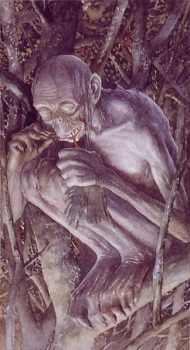 Gollum by Alan Lee
Gollum by Alan Lee
‘And we shouldn’t be here at all, if we’d known more about it before we started. But I suppose it’s often that way. The brave things in the old tales and songs, Mr. Frodo: adventures, as I used to call them. I used to think that they were things the wonderful folk of the stories went out and looked for, because they wanted them, because they were exciting and life was a bit dull, a kind of a sport, as you might say. But that’s not the way of it with the tales that really mattered, or the ones that stay in the mind. Folk seem to have been just landed in them, usually – their paths were laid that way, as you put it. But I expect they had lots of chances, like us, of turning back, only they didn’t. And if they had, we shouldn’t know, because they’d have been forgotten. We hear about those as just went on – and not all to a good end, mind you; at least not to what folk inside a story and not outside it call a good end. You know, coming home, and finding things all right, though not quite the same – like old Mr. Bilbo. But those aren’t always the best tales to hear, though they may be the best tales to get landed in! I wonder what sort of a tale we’ve fallen into?’
‘I wonder,’ said Frodo. ‘But I don’t know. And that’s the way of a real tale. Take any one that you’re fond of. You may know, or guess, what kind of a tale it is, happy-ending or sad-ending, but the people in it don’t know. And you don’t want them to.’
‘No, sir, of course not. Beren now, he never thought he was going to get that Silmaril from the Iron Crown in Thangorodrim, and yet he did, and that was a worse place and a blacker danger than ours. But that’s a long tale, of course, and goes on past the happiness and into grief and beyond it – and the Silmaril went on and came to Eärendil. And why, sir, I never thought of that before! We’ve got – you’ve got some of the light of it in that star-glass that the Lady gave you! Why, to think of it, we’re in the same tale still! It’s going on. Don’t the great tales never end?’
‘No, they never end as tales,’ said Frodo. ‘But the people in them come, and go when their part’s ended. Our part will end later – or sooner.’
 At the Cross Roads by Ted Nasmith
At the Cross Roads by Ted Nasmith
I love Sam’s realization that he personally is an appendix to a tale going back thousands of years. He’s reached this wonderful understanding that he’s in the middle of a story and then it suddenly occurs to him that he’s not even in his own story, but just one more leg on someone else’s. Of course all this gets mangled and bastardized in the movie.
Which brings me to Peter Jackson’s movie, which feels very much like someone other than Tolkien’s story. I’ll only bring up a few of the things that leave me enraged watching his The Two Towers. The easiest one is which two towers the title refers to. The book’s title refers to Orthanc and Minas Morgul. Instead, Jackson has Saruman deliver a line about a new power made of the union of two towers, by which he means Orthanc and Barad Dur. I don’t know if I can say it’s an important thing, but I can say it’s an annoying thing.
Aside from Aragorn falling off a cliff, more bad jokes — dwarf tossing (again!), bad soup, and others — and buffoonishness from Merry and Pippin, there’s the case of Bad Faramir. In the book, Faramir is a throwback to the noblest Men of the West. Unlike his brother Boromir, he fights for the good things, not for the accolades or the desire to perform heroic deeds. He is not tempted by the Ring and helps the hobbits on their way.
Jackson’s Faramir, like Aragorn before him, can’t simply be a hero. He must be flawed and learn something or other before he can achieve his heroic status. That neither he, nor Boromir, are fair skinned with dark hair only makes matters worse.
I’m not that thrilled with how the Battle of Helm’s Deep is handled in the film. In the book, Théoden brings his forces to the fortress for clearly laid out strategic reasons. Here, it’s made out to be some sort of foolish, poorly thought out action. Aragorn argues with him about sending out messengers for aid, something no one in the book would imagine saying for a moment.
The battle never seems as desperate or grim as Tolkien makes it out to be (Haldir, the elf with the five o’clock shadow, getting killed doesn’t count because he’s barely a character). I struggle to image Orlando Bloom’s Legolas acting like this:
He climbed up and found Legolas beside Aragorn and Éomer. The elf was whetting his long knife. There was for a while a lull in the assault, since the attempt to break in through the culvert had been foiled.
‘Twenty-one!’ said Gimli.
‘Good!’ said Legolas. ‘But my count is now two dozen. It has been knife-work up here.’
I can’t bring myself to say anything else about the movie. Yes, we do get to see the Ents destroy Isengard, but even that’s not as cool looking as it’s described in the book. I’m so sick and tired of whining Frodo and the scene with the Ring Wraith and then him threatening Sam makes me nuts. I just tried to watch the animated War of the Rohirrim and I think something broke in my head.
I guess the only thing to do now that I’ve finished The Lord of the Rings is to go to The Silmarillion, The Hobbit, or….Bored of the Rings. Whichever I choose, it’s guaranteed to wash away some of the pain of Jackson’s movie.
Half a Century of Reading Tolkien: Part One
Half a Century of Reading Tolkien: Part Two – The Fellowship of the Ring by JRR Tolkien
Fletcher Vredenburgh writes a column each first Sunday of the month at Black Gate, mostly about older books he hasn’t read before. He also posts at his own site, Stuff I Like when his muse hits him.
There, Wolves: Part II
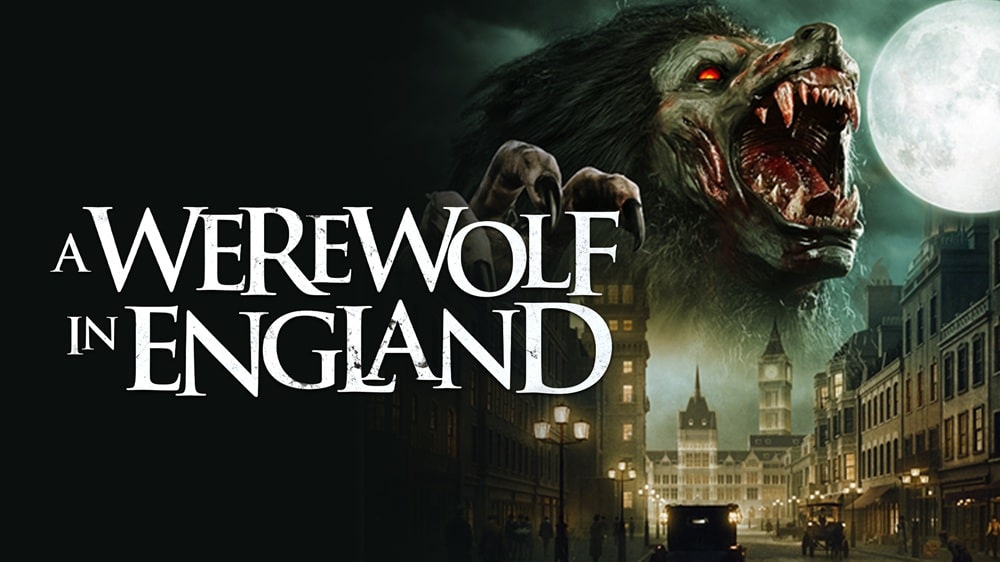 A Werewolf in England (Dark Temple Motion Pictures, 2020)
A Werewolf in England (Dark Temple Motion Pictures, 2020)
A 20 film marathon of werewolf movies I’ve never seen before.
As usual, the films must be free to stream.
I’ve got a bad feeling about this.
A Werewolf in England (2020) PrimeMan or beast? A bunch of hairy honkers.
Howlin’ good time? Hot on the heels of Werewolves Within comes another horror comedy, although this one doesn’t come close to succeeding. It starts well enough, with a title card font reminiscent of the best Bray Studios films, and some gravelly voiced dialects, but it soon regresses into a two-note gag reel of chamber pots and the contents of chamber pots.
Now, I like a good fart or poo joke as much as the next man, but the over-reliance on potty humor soon outstayed its welcome, despite a double dip into demonic diarrhea. There were moments that put me in mind of Motel Hell, but in the end the production was hampered by over saturation (seriously, filter that shit in post), poor sound design and strangely choreographed werewolves.
The beasts, more cuddly than terrifying, could have been really effective with lower lighting and more sparing framing. Oh well — it looked like everyone had fun, and it does feature the line, “I feel a tinglin’ in me nether giblets.”
6/10
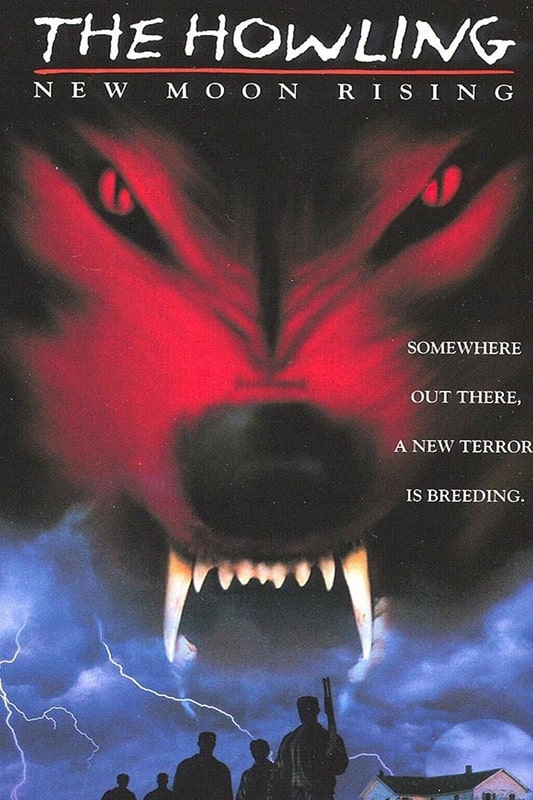
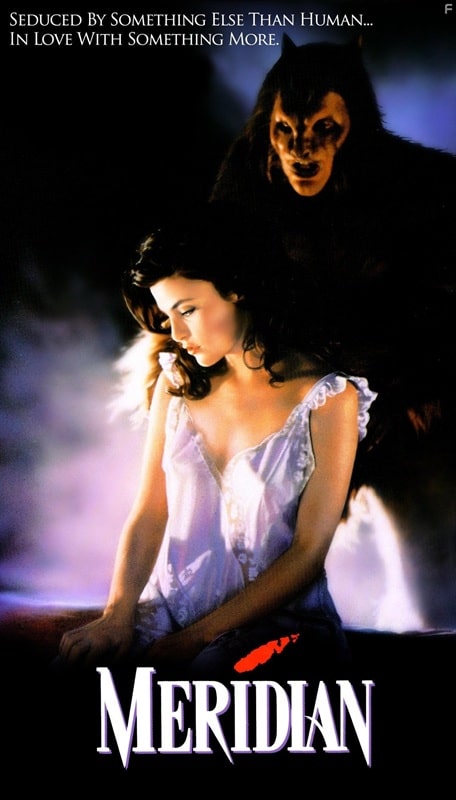
Howling VII: New Moon Rising (New Line Home Video, October 17, 1995)
and Meridian (Full Moon Features, April 13, 1990)
Man or beast? Rubbish practical/CG hybrid for all of 30 seconds at the end.
Howlin’ good time? Good people, if you’ve been reading these reviews, you’ll know I’ve watched some terrible films. You’ll also know that the worst thing a movie can do, in my opinion, is be boring. Forget the fact that this is horribly made, awfully acted, and weaves in footage from the last two films in an attempt to make sense of the story. The first hour of this mess is just unfunny bar regulars line dancing to country music while some bullshit ADR is shoveled on top of the steaming pile of plot. I honestly lost the will to live during this one. Settled for chewing my eyes out.
0/10
Meridian (1990) TubiMan or beast? Nice, practical, beast… wolf… thing.
Howlin’ good time? It’s a Full Moon feature, directed by Charles Band himself and although I think he’s a better producer, this is a nice looking film, suitably gothic for the subject matter. Meridian stars Sherilyn Fenn (and yes, I was a fully carded member of the Cult of Fenn in 1990) in a twist on the Beauty and the Beast story. In fact, it would have been a traditional, romantic ghost/beast story, if not for the unsavoury date rape that kicks off the whole affair.
The beast itself is a curious design, beautifully created by Greg (Lost Boys, Dracula) Cannom, who was definitely enjoying his ‘high brow’ phase. The prosthetics are great, and the body suit is well done; the huge hairy mass on its back is just one of a pair of extraordinary werewolf humps in the film. An interesting watch for purveyors of circus acts, nefarious twins and early 90s bosoms.
7/10
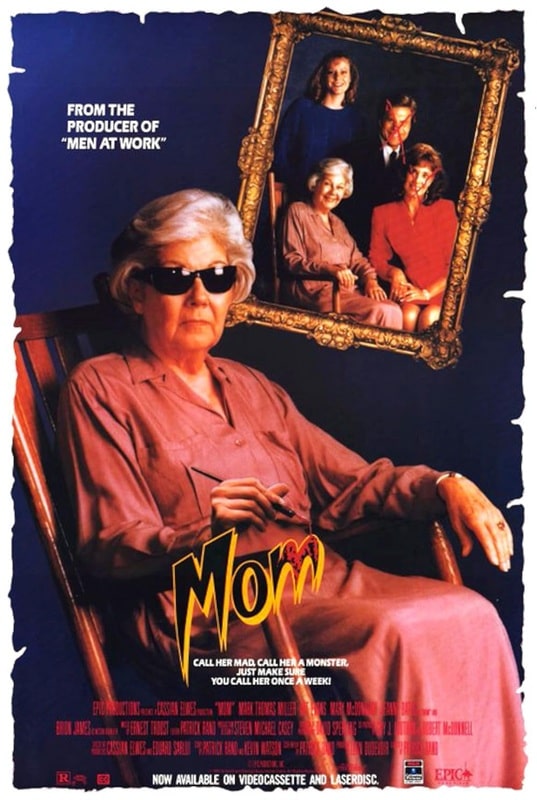
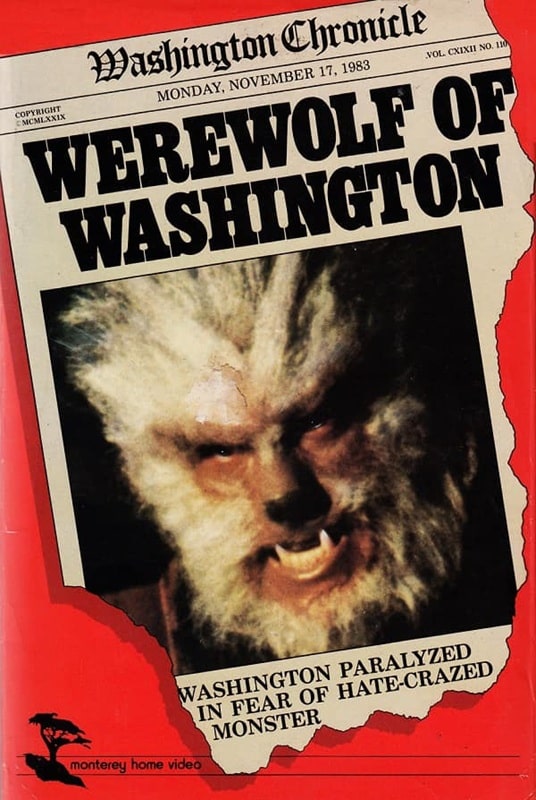
Mom (Epic Productions, June 13, 1991) and Werewolf of Washington (Diplomat Pictures, 1973)
Man or beast? Goofy were-thing.
Howlin’ good time? A 1990s horror film that is so 1990s it hurts. It starts well enough, with the wonderful Brion James as a shady, yellow-eyed drifter being aggressively creepy, and there’s a potentially excellent story to be had when our hero has to deal with his dear old mom turning into a werebeast and eating winos, but it’s not quite as exciting as I had hoped for. The creature itself is only seen in head and shoulder flashes and, although the mid-transformation make up is cool, the final creature looks goofy as all hell — we are talking Rawhead Rex goofy.
Fair to middling.
6/10
Werewolf of Washington (1973) TubiMan or beast? Hairy faced fella.
Howlin’ good time? It’s a scandal that I haven’t seen this before, but I’ve corrected that oversight. Not what I was expecting, this is a political satire wrapped up in a traditional lycanthrope yarn and it’s played for laughs. Skewering Nixon and Watergate, in this flick Dean Stockwell superbly grimaces and gurns as he changes each full moon and makes a meal of the president’s rivals. It’s basically All the President’s Wolfmen. Some genuinely funny moments (a witty script) and remarkable lapses into cinema verité elevate this hokey, bloodless romp into a film that I suspect I shouldn’t have enjoyed as much as I did.
7/10
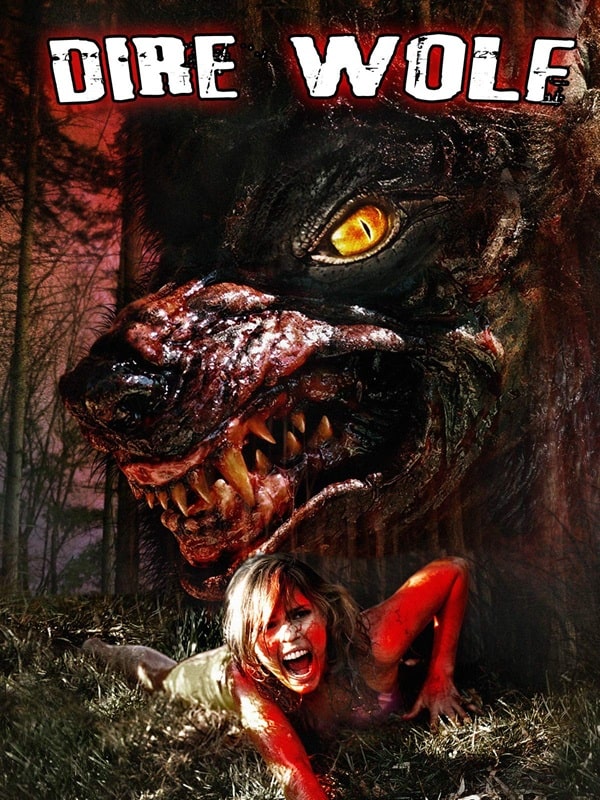 Dire Wolf (Baby Steps Entertainment, 2009)
Dire Wolf (2009) Tubi
Dire Wolf (Baby Steps Entertainment, 2009)
Dire Wolf (2009) Tubi
Man or beast? Wolf/human hybrid.
Howlin’ good time? Bit of a cheat for no. 13, as it’s not strictly a werewolf, but a lab experiment gone wrong. Nothing remarkable about it; it’s typical SyFy fare, a couple of has-beens surrounded by lacklustre actors in a daft plot, with a surprising amount of practical gore. It’s instantly forgettable. However, it did prompt an extraordinary dive into the career of Fred Olen Ray, whom I only really knew for Alienator and Hollywood Chainsaw Hookers. I’m linking the Wikipedia page for his filmography here, as it’s quite the rabbit hole.
Anyhoo – 5/10
Previous Murkey Movie surveys from Neil Baker include:
There, Wolves: Part I
What a Croc
Prehistrionics
Jumping the Shark
Alien Overlords
Biggus Footus
I Like Big Bugs and I Cannot Lie
The Weird, Weird West
Warrior Women Watch-a-thon
Neil Baker’s last article for us was There, Wolves: Part I. Neil spends his days watching dodgy movies, most of them terrible, in the hope that you might be inspired to watch them too. He is often asked why he doesn’t watch ‘proper’ films, and he honestly doesn’t have a good answer. He is an author, illustrator, outdoor educator and owner of April Moon Books (AprilMoonBooks.com).
The Quiet Mindfulness of Page Turning and 8 Transformative Novels
In this LitStack Rec, let’s explore the myriad benefits of page turning and its potential…
The post The Quiet Mindfulness of Page Turning and 8 Transformative Novels appeared first on LitStack.
SHROUD by Adrian Tchaikovsky
DOGE- Supernatural Division (episode 5)
Cover Reveal: Space Ships! Ray Guns! Martian Octopods!: Interviews with Science Fiction Legends, edited by Richard Wolinsky
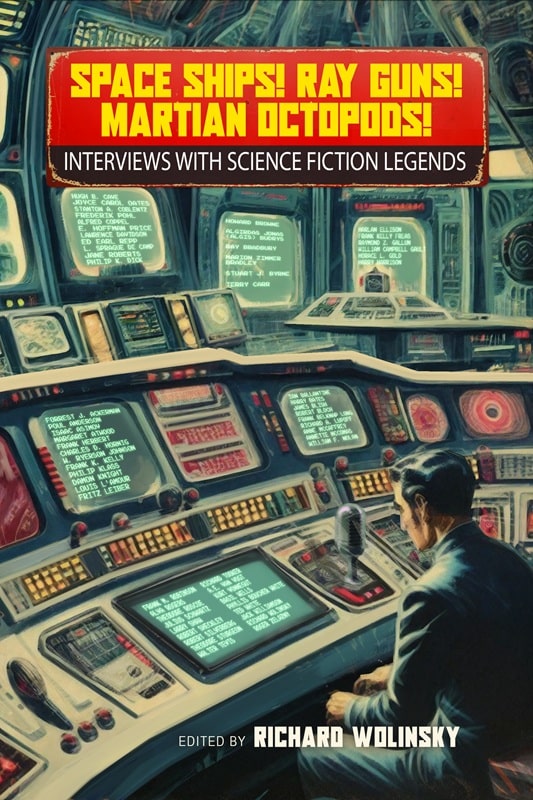 Space Ships! Ray Guns! Martian Octopods!: Interviews with Science Fiction Legends (Tachyon Publications, September 2, 2025). Cover by Yoshi Vu
Space Ships! Ray Guns! Martian Octopods!: Interviews with Science Fiction Legends (Tachyon Publications, September 2, 2025). Cover by Yoshi Vu
At Black Gate, we’re all about science fiction legends. Specifically, science fiction legends who appeared in paperback in spinner racks in the 70s and 80s. Or pulp magazines. Or wrote adventures at the dawn of the role playing industry. You know what, forget all that. We’re not picky.
What makes a true science fiction legend? This is the sort of thing that’s hotly debated on social media, and at science fiction conventions, and in lengthy blog posts titled “Towards a New Science Fiction Canon, Because Yours is Old and Stupid.” But recently, public opinion has shifted. To be a science fiction legend, the most important criteria is that your name looks good in green font on a 50s CRT monitor, preferably in a cool underground bunker. Exactly like the cover of Space Ships! Ray Guns! Martian Octopods!: Interviews with Science Fiction Legends, the upcoming book from Richard Wolinsky and Tachyon Publications.
I’ve spent long hours staring at this cover (by the marvelously talented Yoshi Vu), and the more I do, the more I’m convinced I’m right. Just look at those names. Look at how cool they are! Roger Zelazny, Theodore Sturgeon, Robert Sheckley, Jack Williamson, Fritz Leiber, Damon Knight, Poul Anderson, Isaac Asimov, Anne McCaffrey, William F. Nolan, Terry Carr, Frederik Pohl. Right now you’re shaking your head, but you know I’m right.
Those glowing green names don’t just constitute a comprehensive list of true science legends. Coincidentally, they also happen to be included in this fabulous book of interviews. Don’t take my word for it; here’s the press release to show how right I am.
In this collection of candid interviews, more than fifty legendary authors swap fascinating — and sometimes controversial — anecdotes about the Golden Age of science Fiction (1920–1960). With such guests as Ray Bradbury, Robert Bloch, Harlan Ellison, Philip K. Dick, Isaac Asimov, Margaret Atwood, Fritz Leiber, Frank Herbert, and many more, here are the wild personalities, sparks of contention, and vivid imaginations that made science fiction thrive.
Today, depictions of aliens, rocket ships, and awe-inspiring, futuristic space operas are everywhere. Why is there so much science fiction, and where did it come from? Radio producer and author Richard Wolinsky (Probabilites) has found answers in the Golden Age of science fiction.
Wolinsky has interviewed a veritable who’s who of famous (and infamous) science fiction publishers, pulp magazines, editors, cover artists, and fans. The interviews themselves, which aired on the public radio show, Probabilities, span more than twenty years, from just before the release of Star Wars through the dawn of Y2K. The result, Space Ships! Ray Guns! Martian Octopods!, is ultimately a love letter to fandom.
See? I told you.
I’m not familiar with Richard Wolinsky, but it’s clear that I should be. He cohosted Probabilities, a half-hour public radio program devoted to science fiction, mystery, and mainstream fiction, which aired in San Francisco for nearly twenty years, from 1977 – 1995. After he took the program solo in 2002 he renamed it Bookwaves, and that incarnation is still running.
Space Ships! Ray Guns! Martian Octopods!: Interviews with Science Fiction Legends belongs on every serious science fiction bookshelf. It definitely belongs on mine, anyway.
It will be released from Tachyon Publications on September 2, 2025. It is 256 pages, priced at $18.95 in paperback and $11.00 in digital formats. Get more details and order copies directly from the publisher here.
Oh Crap It's February
Here's an example of a stick that's been beating our entire family:
My 24-year-old cousin was diagnosed a few weeks ago with what ended up being Stage 4 ovarian cancer. She's struggling to survive as we speak. I know that's a very serious shift in tone for this blog, but it is true, and things are still very difficult for her and her immediate family right now.
That alone is enough to make it a long year already.
But on a lighter note, I am making progress on writing! Book 4 of The Last Horizon proceeds on schedule, and an early draft has even gone out to some of the beta readers.
I also almost forgot to blog this month because time passes so quickly. And because I forgot this month only has 28 days. As the rhyme goes, "30 days hath September, plus the ones I don't remember. All the rest have 31, but when you know the month is done, February steals the sun. March and April steal it back, then May stabs April in the back. For August, that ungrateful hack."
-Will
Oh no, not the Hughday?
There might not be a Hughday next week. We have to push through on the editing. But meanwhile we offer extra today.
 Totally not my chicken. Stock Image.
Totally not my chicken. Stock Image.
Bucky clopped down the road, stamping his hooves into the old asphalt with cheerful abandon. The day was bright and lovely. A clear blue sky, flooded with crystalline sunshine and feathered with white clouds, stretched overhead. The magic hit about ten minutes before they left the castle, and Bucky’s coat glowed an ethereal white.
Hugh watched the autumn woods pass by them, awash with yellow, gold, and scarlet. Behind him, Bale rode on a chestnut Morgan mare, and behind the berserker, the delegation from Aberdine chugged along on their horses, grim-faced and looking like someone pissed in their cornflakes. Five Iron Dogs brought up the rear.
Bishop nudged his gelding and caught up, drawing even with Bucky.
Hugh waited.
Bishop cleared his throat.
“Something on your mind?”
“I know your people are good.”
“They are.”
“I mean no disrespect, but there are at least seventy mercs camped out in our field.”
“You mentioned that.”
Bishop glanced behind them.
“You’re bringing six soldiers.”
Hugh pretended to frown. “You think it’s overkill?”
“You know what I mean. They’ve got this guy, Silas. He’s as good as any of yours.”
Silas, huh? “Did Silas do that?” Hugh nodded at Bishop’s arm.
The lawman grimaced. “No. That was Falcon’s personal goons. He’s got these three guys that follow him everywhere. Not especially good, but big and happy to hurt people. You can always tell the types who are in it for a chance to dish out some pain. They get off on it.”
“Good to know.”
They rode for a bit more.
“We could turn around and get more people,” Bishop said.
“No need.”
“I don’t want any of you getting hurt for nothing.”
“Ah, that’s sweet. I didn’t know you cared.”
Bishop heaved a sigh and dropped back.
Bale chuckled softly.
“You watch yourself,” Hugh told him.
“Poor fella is worried about our safety.”
“He is the chief of police. He gets paid to worry about things like that. Besides, you heard what he said. They have Silas.”
“I heard that.” Bale’s eyes lit up. “As good as one of ours.”
“We’ll have to test that.”
The trees parted, and the road unrolled into the open, with Aberdine rising in the distance. Before the Shift, it was a typical small Southern town, with a handful of street lights and gas stations, a Wells Fargo, a firehouse, a school, and too many Dollar Generals. Now a sturdy wooden palisade, reinforced with steel beams, guarded the few blocks inside the city’s center, with scattered homesteads and farms crowding around it.
Like most modern settlements, Aberdine kept a cleared kill zone between the town and the few surrounding farms and the forest. Coller Road, on which they now rode, cut right through that cleared land, leading to the city gate. The gate was shut. Old tents were pitched on both sides of the road, some military issue, others the civilian camping type. People mulled about, dressed in random gear, unshaven, looking hungry.
Hugh scanned the camp. Sloppy. No guards or sentries posted. No signs for designated latrines, no cook tent, no mess hall. No cleared spots for drills and training.
The wind brought a whiff of shit and other human body odors.
Lovely.
The mercenaries glared at them as they rode past.
“Ooh, so much hostility,” Bale said. “I’m beginning to feel unwelcome.”
The bell on Aberdine’s fire tower pealed, ringing out three times.
Hugh looked at Bishop over his shoulder.
“I didn’t tell them to do that.”
So much for the element of surprise.
A group of men moved in front of the gates, blocking the road. The one in front was tall and beefy, with reddish hair cut regulation short, so close cropped on the temples, he looked like he had a short mohawk. Heavy jaw, almost no neck, small cold eyes. The man stared at them like a gator watching a deer sneak in for a drink in his lake.
The five mercs around him didn’t seem any friendlier. They were cleaner than the rest, better fed, better equipped, with some remnants of military bearing, but there was no doubt of it. This wasn’t an organized, disciplined unit with hierarchy and defined roles. This crew was run like a gang, with the clique at the top making all of the decisions. The best possible scenario.
Lamar had been right once again.
They were about twenty yards away from the mohawk and his entourage. Hugh stopped. Everyone behind him halted as well.
“You must be the man in the castle,” the mohawk said.
“You must be Falcon,” Hugh said.
Around them the mercenaries drew closer.
“I am,” the leader said. “Now that we know who’s who, what are you doing in my town?”
#
Elara layered mushrooms and chopped parsnips in the bottom of the Dutch oven. She tossed a few sprigs of rosemary, fresh sage, and thyme on top of that, and reached for the garlic cloves. One, two, six, eight…
“Don’t you think that’s enough garlic?” Savanah said.
“No.”
Ten, fourteen. That should do it. She poured about a cup of white wine into the pot, picked up the chicken, and set it on top of the vegetables. She’d already seasoned it with salt, pepper, and smoked paprika.
The older witch shook her head. Her dark curly hair was wrapped into a tight bun today. She’d recently bought a new pair of glasses with bright red frames that complemented her warm brown skin, and her hair clip matched the scarlet shade exactly.
“Why do you even bother?”
Elara washed her hands and dried them on a blue kitchen towel. “He’s my husband and he asked for something delicious for dinner.”
Savannah rolled her eyes. “We have a fully staffed kitchen.”
“He didn’t ask them. He asked me.” Elara put the lid on, opened the oven, and heaved the heavy cast iron pot into it.
“You could have made something easy. Why this?”
“Because he’s French and Chicken en Cocotte is the only French main dish I know how to make.”
“What is happening to you?” Savannah demanded.
Elara leaned back. “It’s a bargain. I make this and he comes back safe.”
“Who are you bargaining with?”
Elara waved the kitchen towel around. “Fate, the Source of All Life, everything. Whoever is around.”
Savannah threw her hands up. “What about the budget projections?”
“I have them right here.” Elara pointed to a stack of paper on the table.
“In the kitchen?”
“The budget projections don’t care where I read them. I have fifty minutes until I need to take the lid off and turn the fire up. Plenty of time. Just let me get the potatoes cut up.”
Savannah gave her a resigned sigh. “I’ll brew us some tea.”
#
“It’s not your town,” Bishop said.
Falcon squinted at him. “I thought we had an understanding. Instead, you went behind my back. And this was all you could get? Seven men?”
“Hope it was worth it,” a large dark-haired man offered on Falcon’s left.
Falcon glared at him and turned back to Bishop. “You and I are going to have a long talk after I deal with this. It seems to me you still don’t understand the chain of command.”
“I’ll make this short,” Hugh said. “My wife is cooking a delicious dinner, and I don’t want to be late. Aberdine doesn’t want you here. You have an hour to clear out.”
Falcon smiled. Behind him a couple of his heavies chuckled. “Is that so?”
“It is.”
Falcon squinted at him. “The folks in town tell me you’re some kind of a big deal. Well, that doesn’t mean shit to me.”
Why was it always the hard way?
Hugh let out a bored sigh. “We can kill the lot of you, but it would take a while and I’m getting hungry. Why don’t you pick your best guy, and I’ll pick one of mine. Sound fair?”
The mercenary leader gave him a calculated look, surveyed Bale and the five Iron Dogs behind him, then glanced at the tents. Falcon was not a complete fool, or he wouldn’t be able to hold this lot together. Bishop had left to get help, and now seven soldiers rode straight into Falcon’s camp. The numbers were clearly on his side, yet this new group was unbothered and their leader was now giving him orders.
Hugh could practically feel the wheels turning in Falcon’s head. The merc leader was thinking that the magic was up, so it was likely a factor. He had to suspect that they had an ace up their sleeve, and Hugh had just handed him a chance to see what it was. In Falcon’s mind, they could see what they were up against and even if they lost, they could always swarm them after. They had ten times as many warm bodies.
“Cherry, go get Silas,” Falcon ordered.
The dark-haired man who ran his mouth earlier took off and disappeared between the tents.
A minute passed. Another.
Cherry double timed back, slightly out of breath. A blond man followed him, carrying a katana in the traditional saya scabbard. He wore a black turtleneck, loose-fitting athletic pants, and dark tennis shoes. His hair was cut short, his jaw was clean shaven. He glanced at Hugh, his expression flat, and stopped in front of Falcon.
“Here he is,” Cherry announced.
“They want to put one of theirs against one of ours,” Falcon said. “I need you to explain to them why that was a bad idea.”
Silas turned and took five steps forward. He stood about five ten, with the kind of build that came from living by the sword – lean, spare, but strong, as if he was twisted together from steel cables.
Bale got down from his horse and made a show of loosening up his shoulders and back. “So, you’re their secret weapon?”
Silas didn’t answer. His gaze was fixed on Hugh as if Bale didn’t even exist.
Bale lumbered closer and scrutinized the swordsman. “What is this shit you’re wearing? Must be very high speed.”
The look on Silas’ face turned slightly desperate.
Falcon grinned in anticipation. The man was clearly loving this.
“Get them, Silas,” Cherry called out.
Silas held still.
“Have you got anyone else?” Bale leaned to the side to look past Silas at Falcon and his mercenaries. “This one looks a bit beaten down and half starved.”
“Silas!” Falcon snapped.
Silas didn’t move. He seemed in pain.
“What are you waiting for?” Falcon snapped.
Enough was enough. It was time to put Silas out of his misery.
“I’m waiting for you to put one of your men up for the fight,” Hugh said.
“Are you stupid?” one of Falcon’s men demanded.
“My man is standing in front of you,” Falcon said.
“No,” Hugh said. “These are both my men.”
Something broke in Silas’ expression, as if a wall inside him came crashing down.
The mercenaries stared at them.
“Dog!” Hugh called out.
Silas snapped to attention. “Yes, Preceptor!”
“Kill the next man who steps forward.”
“Yes, Preceptor!”
Silas pivoted around, faced Falcon, and unsheathed his sword.
Bale draped his arm around Silas’ shoulders. “You remembered how. See, I knew it would come back to you.”
“What the fuck is going on?” Falcon roared.
Hugh put some steel into his voice. “Put a soldier up or concede.”
Falcon stared at Silas. “Have you lost your fucking mind? What do you think is going to happen to your wife after we kill these assholes? Do the fucking math –”
Bale charged forward, mace in hand, the muscles on his right arm boiling and ballooning into a massive limb. None of the mercs had time to react. The berserker swung, monstrous muscle flexing. The mace whistled through the air and smashed into Falcon’s face. The mercenary leader’s skull cracked like an egg under a hammer. Chunks of brain and bone exploded, splattering onto the other men.
Bale twisted. Flesh rippled across his frame. His voice was a low inhuman growl.
“Who else wants to threaten my sworn brother’s family?”
He pointed the mace at the largest merc. “Is it you?” The mace moved to Cherry. “You?”
They backed away from him.
On the left, one of the mercenaries in the field by the tents raised a crossbow. On the right a mage was chanting, building up power and winding it into a bow like cotton candy on a stick.
Hugh pulled the magic to him and opened his mouth. “Osanda sapawur daas kair.”
Kneel before me and be silent.
The power words tore out of him, shaping the very matrix of magic. Power pulsed from Hugh, exploding in all directions like a blast wave from a bomb.
Seventy pairs of knees hit the dirt. The entire camp knelt as one. Only Bale, Silas, and the riders stayed where they were.
The mercenaries’ faces contorted. They were trying to rise, trying to scream, and couldn’t do either.
Silence claimed the field. You could hear a proverbial pin drop. Above them a hawk swooped, crying out.
This was the ancient power he had inherited from the Builder of Towers. He shouldn’t have been able to use it. Roland had purged him, ripping that gift away from Hugh, and yet there it was.
He’d been practicing for the last month, and the magic was getting easier. Every time he used a power word, it hurt less. He’d timed this one for about 10 seconds, because he wanted helplessness to sink in until it birthed terror. To the mercenaries kneeling on the field, every moment would stretch into eternity. They were panicking now. He saw it in their glassy eyes.
“One hour,” Hugh ordered. “Get your shit and be gone.”
The magic ran its course. The spell collapsed and the entire camp fell to the ground.
Bale hefted the mace onto his shoulder. “Silas, we looked for you everywhere. Look at you! You got married and none of us were invited. Introduce me to your wife, you bloody ass. I can’t wait to meet her.”
Silas turned to Hugh, his eyes still haunted and desperate.
“Preceptor, there is something wrong with my wife.”
Of course, it couldn’t be that easy. Hugh swung out of the saddle. “Lead the way.”
Elara’s Chicken en Cocotte with Roasted Young PotatoesModified from Christopher Kimball’s Milk Street recipe. The original is behind a paywall, but I highly recommend the subscription.
Chicken
- 1 3-4 pounds whole chicken
- 10-12 garlic cloves
- 3-4 parsnips, peeled and cut into large chunks
- 1 lb brown mushrooms, sliced into large chunks or whole if they are small
- 3 thyme sprigs
- 1 sprig sage
- 1 cup white wine (I used 2021 High Planes Rose from Lewis Wines)
- 1 small bunch of parsley
- butter, salt, pepper and smoked paprika
Roasted potatoes
- 1 5lb bag of young gold potatoes
- 1/4 cup of animal lard (if you are not BFFs with Grace Draven who sent me Wagyu beef lard, any lard will do. Duck fat would be great. You can do butter. You can also go with the olive oil for a healthier spin. But Wagyu lard was to die for.)
- A dash of Italian seasoning
- salt, pepper
You need a large Dutch over for this.
- Heat the over to 350 degrees with the rack in the center. Season the chicken with salt, pepper, and smoked paprika.
- Throw mushrooms and parsnips into the Dutch oven, arranging them in a single layer if possible. Scatter whole garlic cloves and sprigs of herbs on top of the vegetables.
- Pour 1 cup wine and 1 cup water over the vegetables. Place the chicken on top of the vegetable layer and put the lid on. Bake at 350 for 50 minutes.
- Remove the pot from the oven. Melt some butter and brush it over the chicken. I ended up using around 1/4 cup of so. Return the chicken, uncovered, to the oven and turn it up to 450. Cook, uncovered, for 30 minutes or until the temperature of the thighs or breast reaches 175. The chicken will brown and develop a nice crust.
- Remove the pot from the oven. Using tongs, place the chicken into a deep platter or baking dish, tent with foil. (The original recipe used leeks and returned the Dutch oven to the over for another 10 minutes. I hate leeks, so my vegetables were perfectly cooked.) Discard herbs and half of the garlic. Remove vegetables to a serving platter. Mash the remaining garlic into paste in the Dutch oven.
- Turn off the oven – super important step I sometimes forget.
- After the chicken rested for about 10 minutes or so, remove it onto the cutting board. Pour the drippings from the platter into the Dutch oven. Set the Dutch oven on the stove and bring to boil, whisking the sauce. (Because I am a savage and I know my family’s tastes, I whisked about 1/3 packet of powdered turkey gravy into the sauce, but you can skip this step.) Cook until thickened. Mix in finely chopped parsley.
- Carve the chicken to your preference and arrange it on the platter on top of potatoes and vegetables. Or serve everything separately. (I served separately.) Pour the sauce over the chicken – it will be divine – and definitely serve it at the table.
Potatoes
- While the chicken is baking for that initial 50 minutes, wash the potatoes and slice them in half. Place the potatoes into a bowl, season with salt, pepper, and a dash of Italian seasoning, mix well, add you choice of melted fat or olive oil, mix again. dump the potatoes onto a baking sheet lined with parchment paper for the ease of cleaning. Arrange them cut side down. You wouldn’t think they would brown with paper, but they do.
- When you remove the chicken from the oven for the first time and turn the heat up to 450, pop the potatoes on the bottom rack. They will need roughly 40 minutes to bake, but you might want to check them at 30, depending on how small your potatoes are. The cut side should be crispy and the top side should be soft.
Grace Draven made her chicken with leeks, so if you want to ask her about it, here is her website and Facebook.
The post Oh no, not the Hughday? first appeared on ILONA ANDREWS.
Comment on End of Winter Update by Brian
In reply to Celia.
We give them swords and let them fight to the death?
The Enchanted Greenhouse - Early Book Review
 The Enchanted Greenhouseby Sarah Beth Durst
The Enchanted Greenhouseby Sarah Beth DurstWhat is it about:New York Times bestselling author Sarah Beth Durst invites you to her new standalone novel nestled on a far-away island brimming with singing flowers, honey cakes, and honeyed love. The hardcover edition features beautiful sprayed edges.
Terlu Perna broke the law because she was lonely. She cast a spell and created a magically sentient spider plant. As punishment, she was turned into a wooden statue and tucked away into an alcove in the North Reading Room of the Great Library of Alyssium.
This should have been the end of her story . . . Yet one day, Terlu wakes in the cold of winter on a nearly-deserted island full of hundreds of magical greenhouses. She’s starving and freezing, and the only other human on the island is a grumpy gardener. To her surprise, he offers Terlu a place to sleep, clean clothes, and freshly baked honey cakes—at least until she’s ready to sail home.
But Terlu can’t return home and doesn’t want to—the greenhouses are a dream come true, each more wondrous than the next. When she learns that the magic that sustains them is failing—causing the death of everything within them—Terlu knows she must help. Even if that means breaking the law again.
This time, though, she isn’t alone. Assisted by the gardener and a sentient rose, Terlu must unravel the secrets of a long-dead sorcerer if she wants to save the island—and have a fresh chance at happiness and love.
Funny, kind, and forgiving, The Enchanted Greenhouse is a story about giving second chances—to others and to yourself.
What did I think of it:*I was lucky enough to get a digital Advance Reader Copy of this book*
This is a standalone set in the same world as The Spellshop, but anyone who read and loved The Spellshop will recognize who Terlu is, and so needs to read this! New to this world? You can totally read and love this book without reading the Spellshop first, but believe me: you need both these books, they're both awesome!
I liked Terlu, and had a lot of sympathy for her, but then the grumpy gardener Yarrow was introduced, and just Wow! He and I have a lot in common I have to confess. From that point on I so rooted for the both of them,(maybe a little bit more for Yarrow) that they would succeed in saving the greenhouses.
I feared one of my least favorite tropes would happen in this book, and it did, but Durst managed to write it in a way that didn't make me want to puke like I usually do with this particular trope (which I will name the 'Shiny Happy People' trope to not spoil too much).
So with a certain trope handled in the best was possible this was just as beautiful and emotional a read as The Spellshop. I loved reading about the wonders in the greenhouses, and learn more about the world Durst created. There's tons of beauty and whimsy, next to a really emotional story that also has lots to smile about.
You bet I will impatiently wait for the release and get my trotters on the hardcover to place it next to The Spellshop. And if there's to be more books: I'm going to hope it will be about certain characters who have a small role in this book.
Why should you read it:It's a great, cozy Fantasy with a wonderfully grumpy gardener.
Expected publication: July 15, 2025 by Bramble
Goth Chick News: Time Stands Still in Pause: John Carpenter’s Latest Sci-Fi Horror Comic
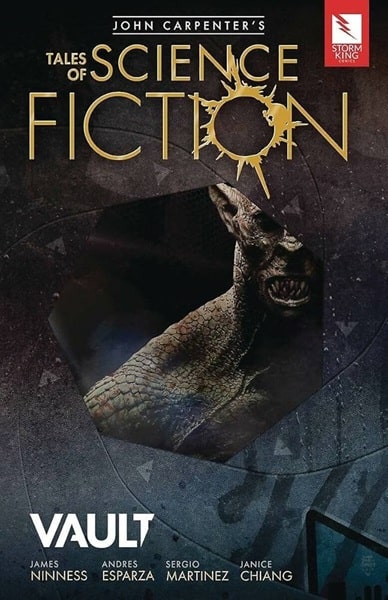
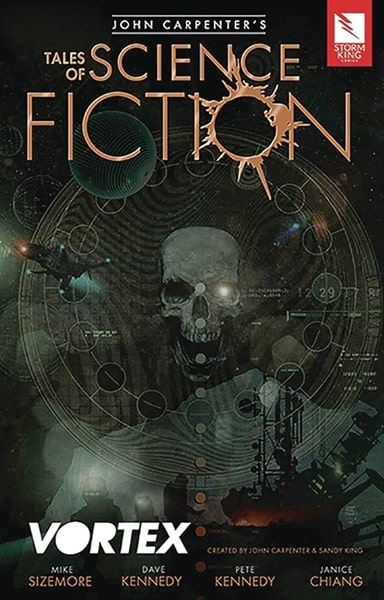
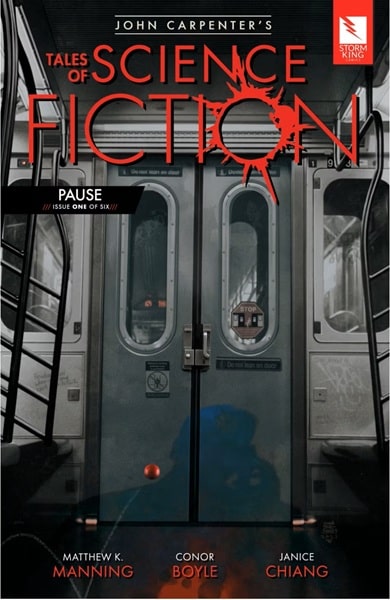
John Carpenter’s Tales of Science Fiction: Vault (June 2018), Vortex
(October 2018), and issue #1 of Pause (February 26, 2025
Storm King Comics was founded in 2012 by legendary filmmaker John Carpenter and his wife of thirty-five years, producer Sandy King. Together, they are known for delivering stories of horror, science fiction, and the supernatural, with series like John Carpenter’s Tales of Science Fiction and John Carpenter’s Tales for a HalloweeNight. Combining Carpenter’s cinematic style with the visual storytelling of comics, Storm King Comics offers fans immersive experiences that have cemented its reputation in the comic book industry.
I was first introduced to Storm King Comics by the grand dame herself, Sandy King, when I met her in 2016 at C2E2. Since then, I have collected all the issues from Tales for a HalloweeNight as well as Asylum which was my first exposure to the great stories that come out of Storm King. And though I am not a sci-fi girl strictly speaking, I love a good crossover, which this week’s launch seems to be.
For a bit of background, John Carpenter’s Tales of Science Fiction launched in 2018 with its inaugural story Vault, telling the tale of a moon-bound crew who discover an alien vessel with English markings. Since that time there have been eleven total installments and this week the series returns with installment twelve, entitled Pause.
Here’s what you have to look forward to…
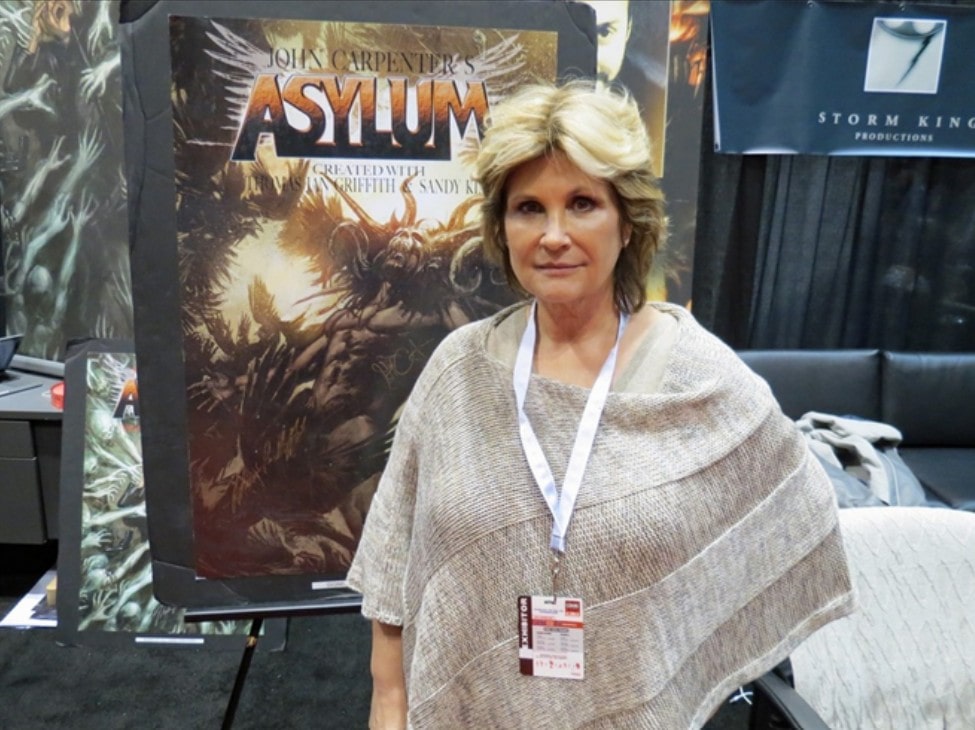 When I met Sandy in 2016
When I met Sandy in 2016
Picture this: you’re the only one not frozen in a world where time has stopped. You could lounge in a luxury Manhattan penthouse while its owner stands motionless nearby. You could feast on gourmet meals, perfectly hot and untouched, at high-end restaurants.
But what if you could bring others back to life with just a touch? Would you break the silence for companionship — or keep this frozen paradise all to yourself? The possibilities seem endless, but in a world like this, making the wrong move could unpause more than you bargained for…
Check out the trailer set to “Beyond the Gallows” from Carpenter’s latest album, Lost Themes IV: Noir.
Pause is written by Matthew K. Manning (Batman/Teenage Mutant Ninja Turtles Adventures), illustrated by Conor Boyle (Judge Dredd), and lettered by Janice Chiang.
Issue #1 of the six-issue limited series is available today, with new issues arriving monthly through August.
Comment on Worldbuilding Articles: 2025 Reader Poll Results by Rebecca Newsome
In reply to Cindy Houghton.
I really like the body piercing aspect but would go one step further with direct implants into the skin. Wonder if that would work? Maybe allow you to keep a certain powerful sigl close to an area of the body that it needs to sit in to work correctly. Has anyone brought this up already and I’ve missed it?
Review of Mother of Rome by Lauren J. A. Bear
As a Bookshop affiliate, I earn from qualifying purchases. Book Description: A powerful and fierce reimagining of the earliest Roman legend: the twins, Romulus and Remus, mythical founders of history’s greatest empire, and the woman whose sacrifice made it all possible. The names Romulus and Remus may be immortalized in map and stone and chronicle, but their mother exists only as a preface to her sons’ journey, the princess turned oath-breaking priestess, condemned to death alongside her children. But she […]
The post Review of Mother of Rome by Lauren J. A. Bear first appeared on Fantasy Cafe.
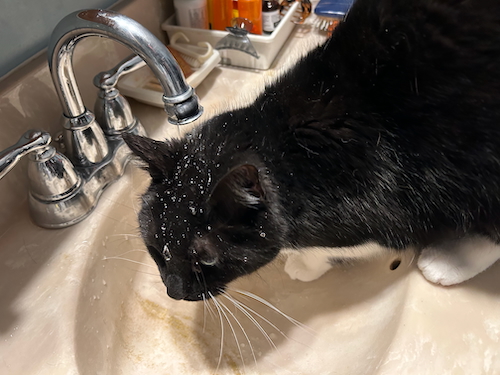

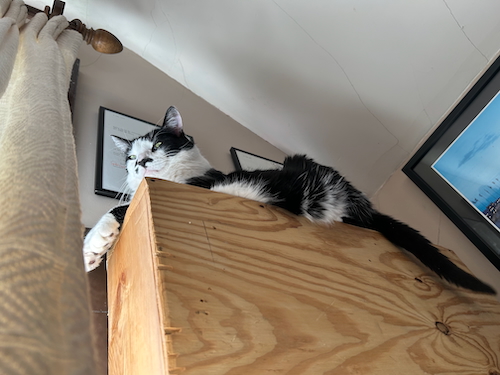
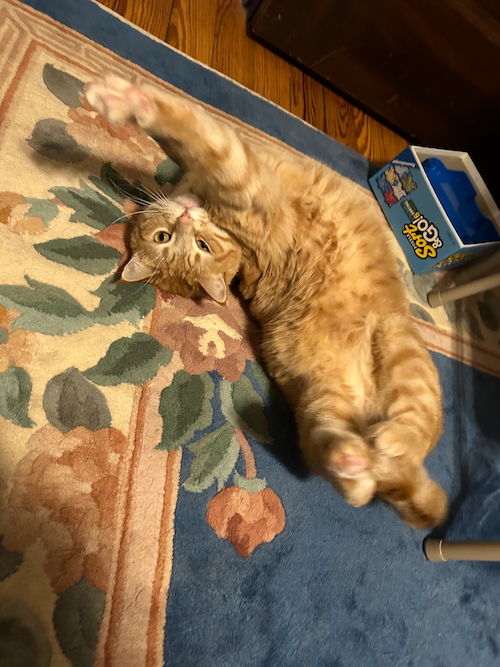
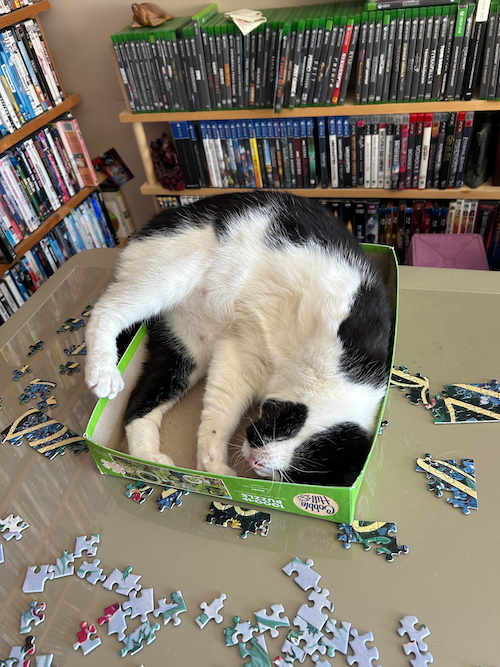
Recent comments